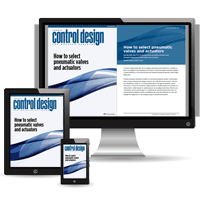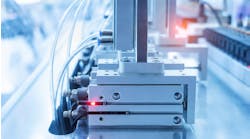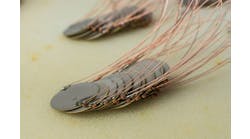A Control Design reader asks: We are adding a pneumatic pick-and-place to a machine as part of an upgrade to automatically load the parts. The pick-and-place mechanism replaces a manual operation on a six-second-cycle-rate machine, picking and placing a small, fragile plastic part.
The pick-and-place mechanism consists of a horizontal pneumatic actuator, vertical pneumatic actuator and pneumatic gripper actuator, each with end-of-travel sensors, that will be controlled by a small PLC. I'm a bit confused about what type of pneumatic valves I should use to control the mechanism. Single solenoid vs. double solenoid, two-position vs. three-position, center exhaust vs. center pressure are clouding my decisions. What do you recommend I use for each actuator? To complicate the selection process even more, I'm concerned that dumping air under an emergency will cause the mechanism to lower and damage the fragile part, so I am looking at ways to minimize this scenario.
Know the center
Kent Darnell, CFPAI, CFPHS, business unit leader, hands-on training department, Womack Machine Supply, Farmers Branch, Texas: The machine designer is adding a pick-and-place robot to his machine and is confused about the type of pneumatic valves he needs to use. The machine has three actuators—a horizontal actuator, a vertical actuator and a gripper. The machine will be controlled with a small PLC and will have end-of-travel sensors on the actuators. Cycle time on the machine is six seconds, and one of the concerns is that dumping air might damage the part. When designing any machine, there will always be more than one way to design it, and there will be many different options of what to use. The machine designer is confused about all of the options available with the pneumatic valves, and he mentions three different parts of a pneumatic valve, the solenoids, the positions and the exhaust and is wondering which to use in his application. The pneumatic valve directs air into the pneumatic actuators so that actuator will extend and retract. The valve controls the air by a spool in the valve and is moved by an armature that is controlled with a coil. The armature-and-coil combination is called a solenoid. Figure 1 shows a cutaway view of a four-way, three-position directional valve with double solenoids. When the solenoid on the left actuates, it pushes the spool to the right and air will flow from Port P to Port A and from Port B to Port EB, which will either extend or retract the pneumatic actuators on the machine. When both solenoids are turned off, the springs center the spool and block all of the ports from air flow.
To turn this valve into a two-position valve, a solenoid and a spring are removed; now, the valve is either flowing from Port P to Port A and Port B to Port EB or flowing from Port P to Port B and Port A to Port EA (Figure 2). The difference between the two-position valve and the three-position valve is that, on a three-position valve, two outputs will be required from the PLC and the valve can be turned off, whereas the two-position valve will always be actuated with either the solenoid or the spring. On this application, a two-position valve could be used for the horizontal pneumatic actuator and the gripper actuator, and this will save outputs on the PLC. However, the vertical actuator may need a three-position valve. There was a concern about the mechanism lowering and damaging the fragile part; if the machine had to be stopped, the three position valve could “center,” blocking all of the ports to the actuator and stopping it from falling and damaging the part.
The last concern was whether to use center exhaust or center pressure; this is referring to the ports. The center pressure port valve is the most common, and the advantage to using it over the center exhaust is that meter-out flow controls can be installed in the dual exhaust ports and can be used to control the speed of the pneumatic actuators. A center exhaust valve’s advantage is it can have dual pressures going into the valve. A center pressure valve can be converted to a center exhaust valve, if the valve can have pressure on ports EA and EB; this converts the valve from a four-way valve to a five-way valve. In the machine’s design a center pressure port would be recommended. Figure 3 shows a proposed pneumatic schematic for the pick-and-place addition of the machine.
ALSO READ: Pneumatic use is all about the fundamentals
Safety-driven selection
Chico Marks, maintenance manager, Subaru of Indiana Automotive (SIA), Lafayette, Indiana: We can narrow your design options fairly easily. However, while the application is fairly straightforward, there are a few design criteria that you did not call out in your submission. These will need to be addressed before a final design can be determined. The primary additional concern is human interaction with the equipment and how that relates to operator and maintenance personnel safety. To begin, we can look at what we do know about your question.
First, we should look at the basic pneumatic components that will be required. You are designing a three-axis, pick-and-place machine using one horizontal and one vertical axis with a pneumatic gripper on the end of the vertical axis. In order to control this machine, you will need two travel cylinders and one pneumatic gripper. For control you should use one valve per cylinder controlled by the machine PLC. This is where your question comes into play: What types of valves should be selected? You ask about two-position and three-position valves, single and double actuators and center configurations. Let us look at the number of valve positions.
Both two-position and three-position valves will work in this application, but the behavior of the machine will differ depending upon your design choices. The major difference that you will experience is in the two travel axes. The two-position valves will allow you to control the direction of travel (up and down or forward and back) but will not allow you to stop the equipment midstroke of the cylinder through PLC control. In other words, once you start a cylinder in motion it will travel to the end stop of that axis unless you shut off air to the machine. A three-position valve will allow you to stop midstroke. From a normal operation perspective, this may not seem like a problem until you take human safety into consideration.
The second part of the question is whether a single- or double-solenoid valve (single-acting or double-acting) is better for this application. The number of solenoids on a valve determines how the equipment will behave when the PLC output turns off. Standard valve design will give you a one- or two-solenoid option for two-position valves, but three-position valves typically require two solenoids. A single-acting valve will use a PLC output to initiate travel in one direction when the PLC output is turned on. When the PLC output is turned off, the cylinder will return to the original position. A double-acting, two-position valve will initiate travel in one direction with the first PLC output. To reverse direction of travel, the first output is turned off and a second output turned on. If the valve is three-position, turning off both outputs will cause the valve to shift to the center position. These differences can be very important when it comes to human safety and machine interaction. A common safety-circuit design involves cutting output power to control devices in the event of an emergency stop or safety gate entry. The loss of output power is the same as turning off an output. Therefore, using a single acting valve can result in unintentional movement as a result of using a safety device intended to stop equipment movement.
The final two parts of your question revolve around what type of center configuration to use if you select a three-position valve. You would like to protect a fragile part from damage while also controlling motion of the machine correctly. This is where we get back to the missing design criteria that I mentioned earlier. You should look at the possible human interaction with the equipment before making this determination. A pressure-center or closed-center valve will give you the most protection for your part, but it can also leave a person trapped in a pinch point with the actuator under pressure. An exhaust center will almost certainly drop your part, but it would prevent a person being trapped under pressure. It would also create the potential for the vertical axis to drop creating a pinch point from a gravity-stored potential energy hazard. As you do not specify the size of the parts or actuators, it is difficult to recommend the appropriate blend of part protection and human safety without additional information. If the machine is large and carrying heavy parts to or from a human workstation, you would choose differently than if the machine is lightweight, well-protected and isolated by safety devices and distance and has no direct human interaction.
Obviously, it is not possible to give you the completed design specification from the information contained within your question. However, based on what I already covered, I can make a few recommendations. First, understand the safety impact and make that your primary driver of design selection. Second, double-acting valves will give you more control of the equipment under abnormal situations than single-acting valves. Finally, closed or pressure center valves will help to protect your part, but they may introduce a safety concern.






